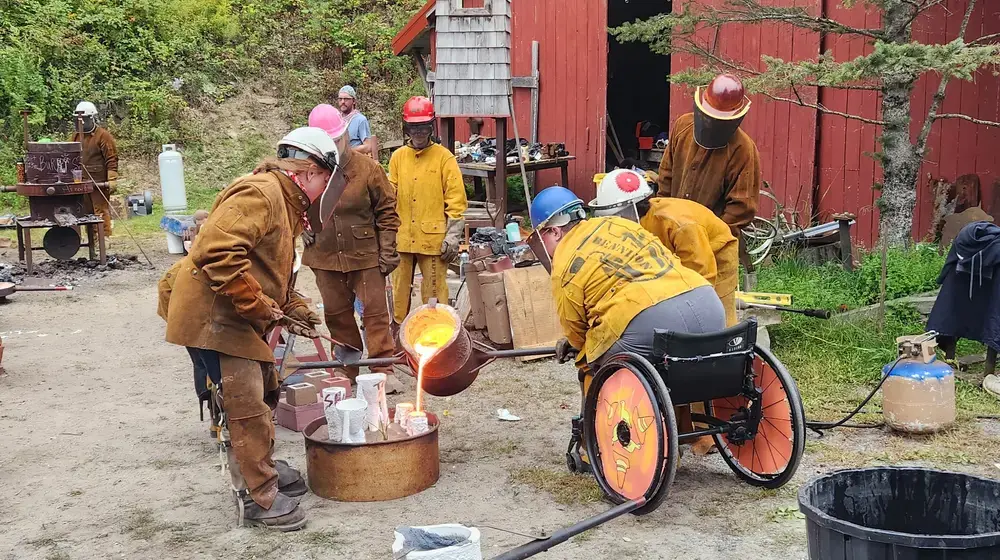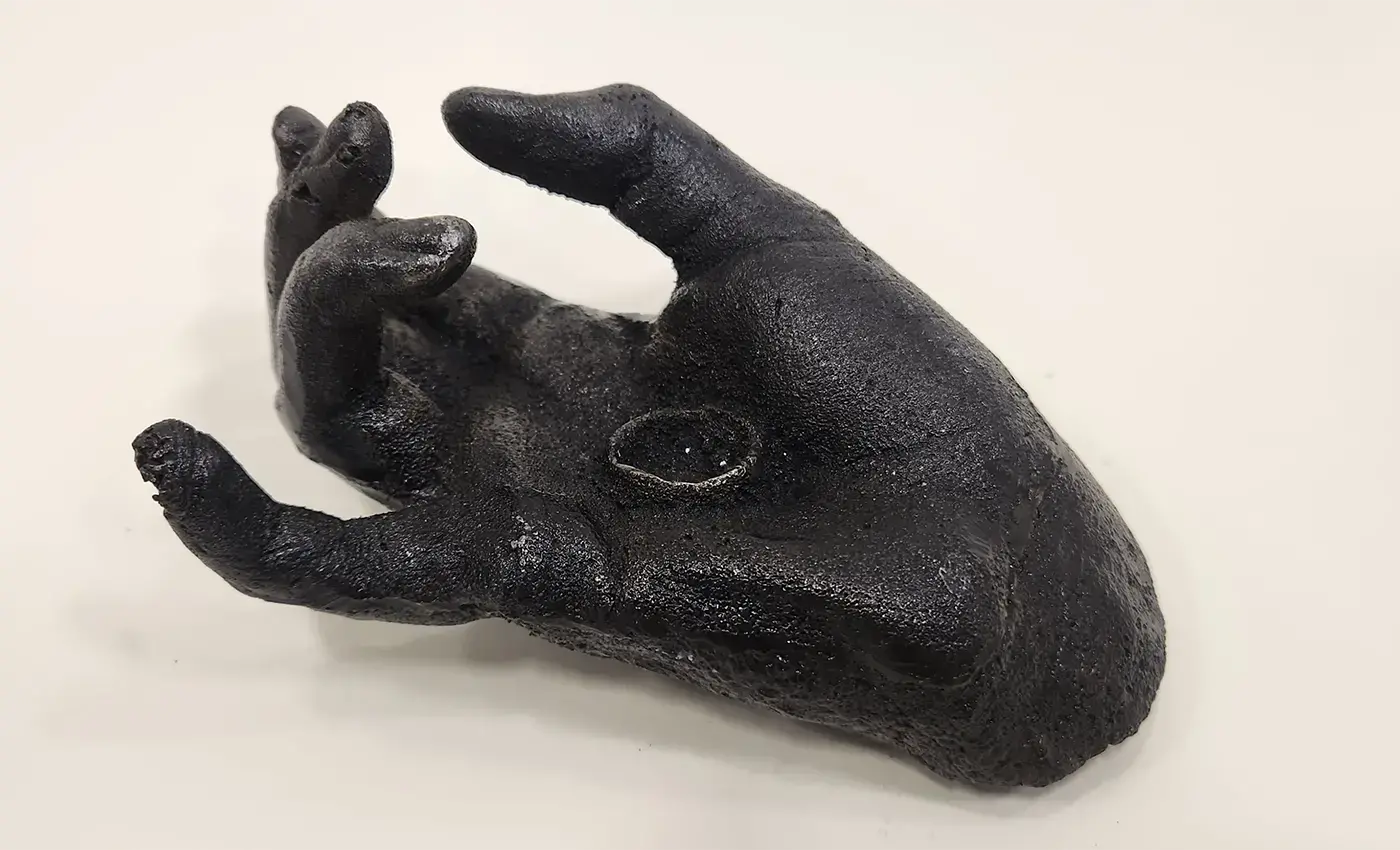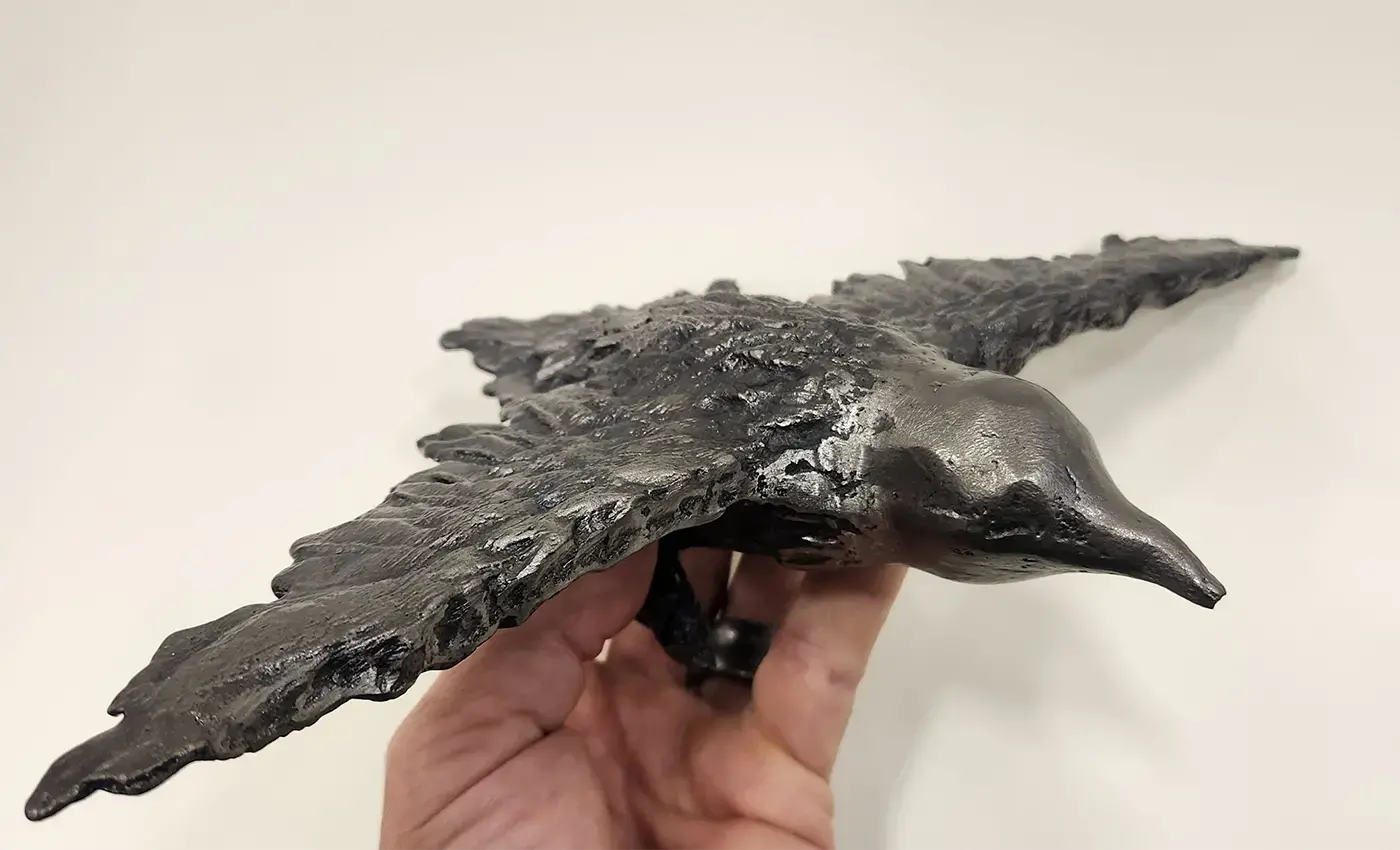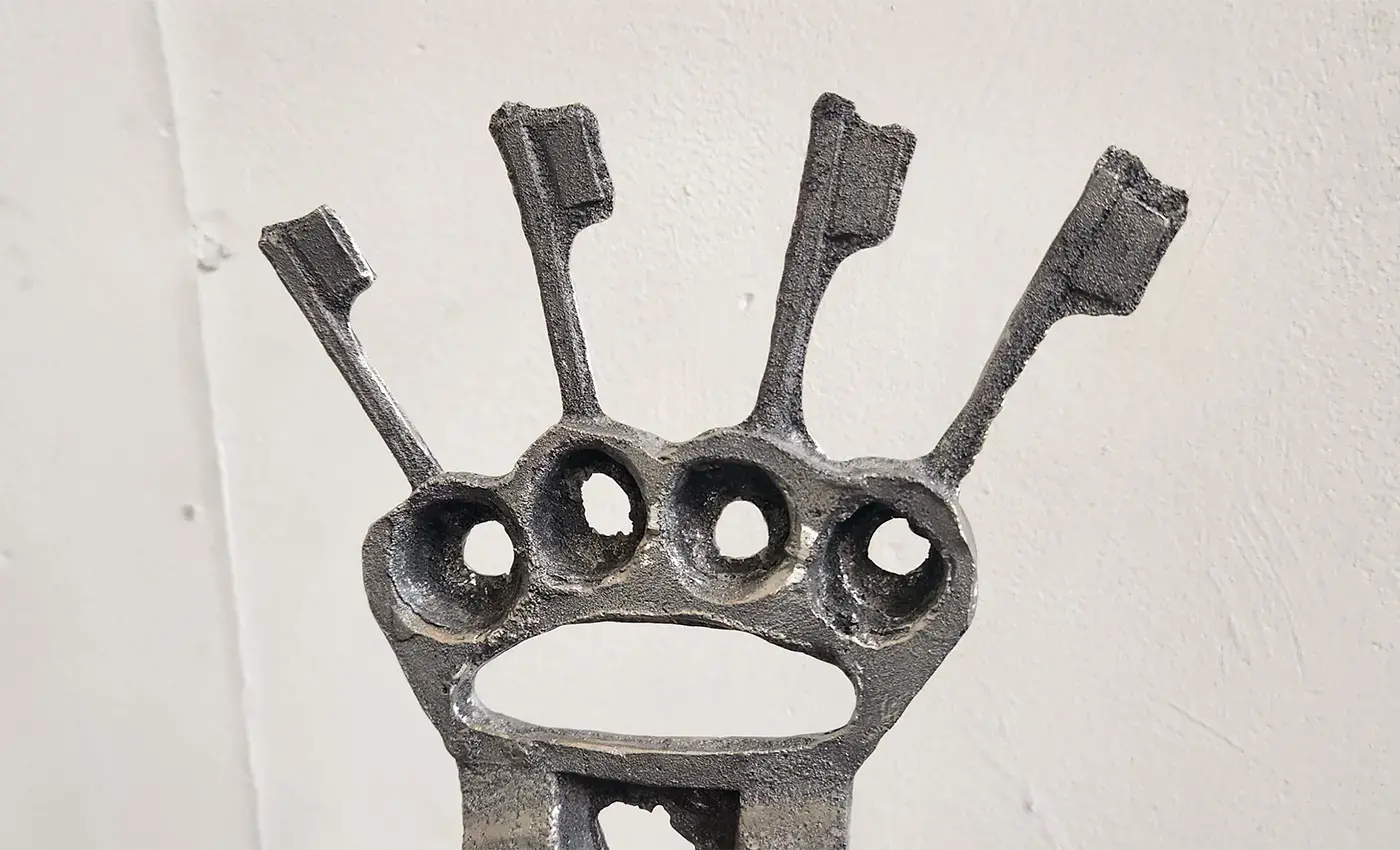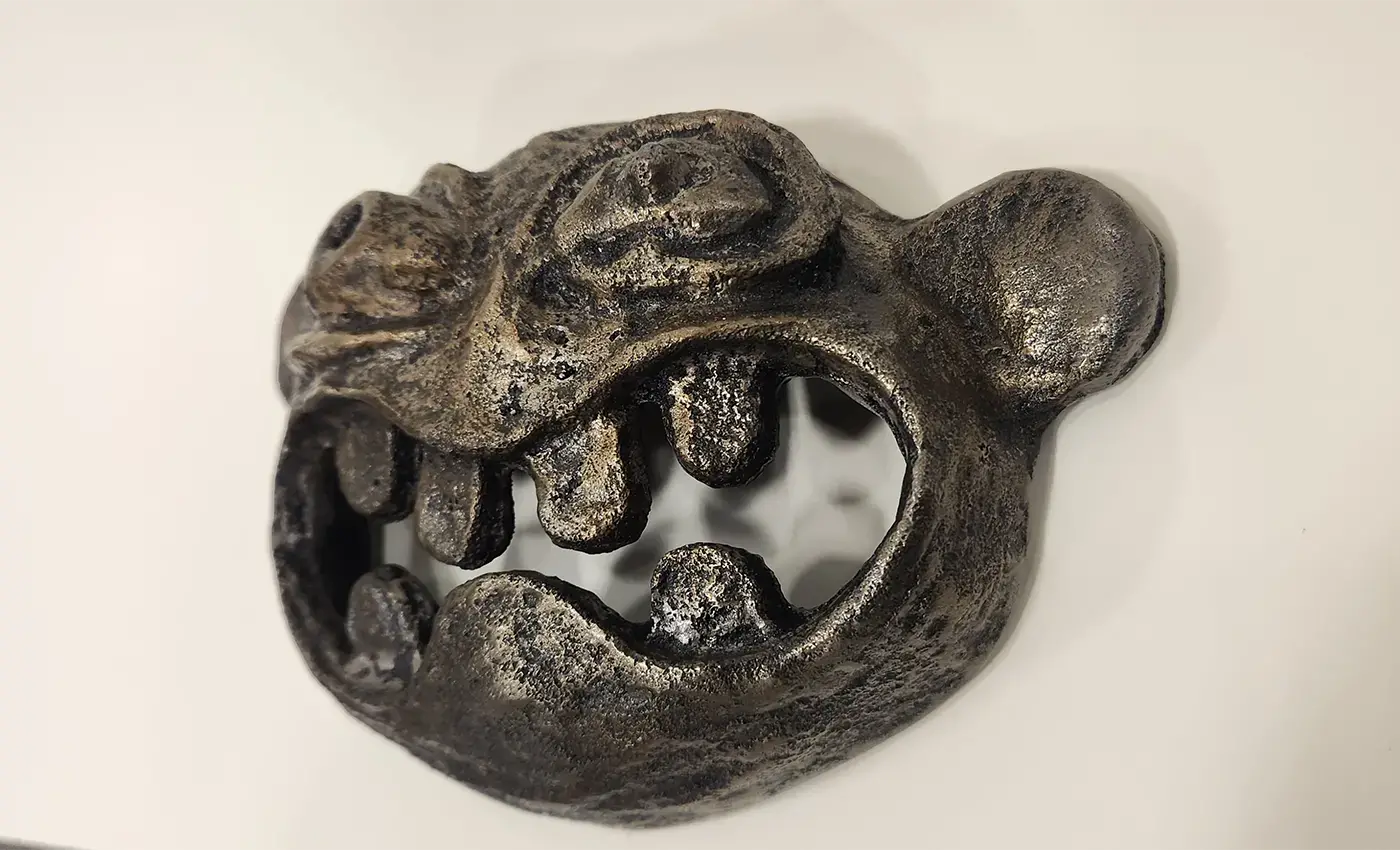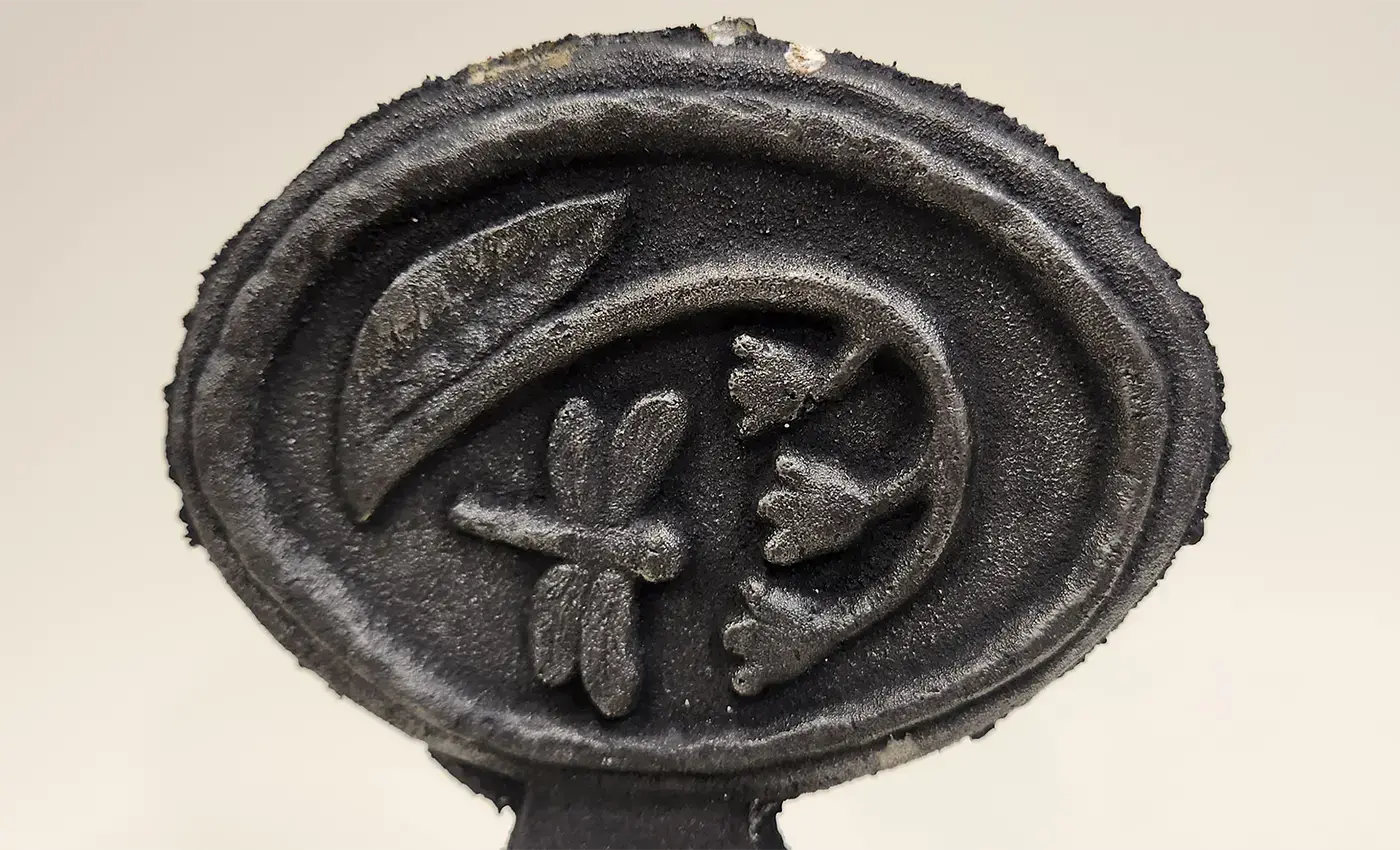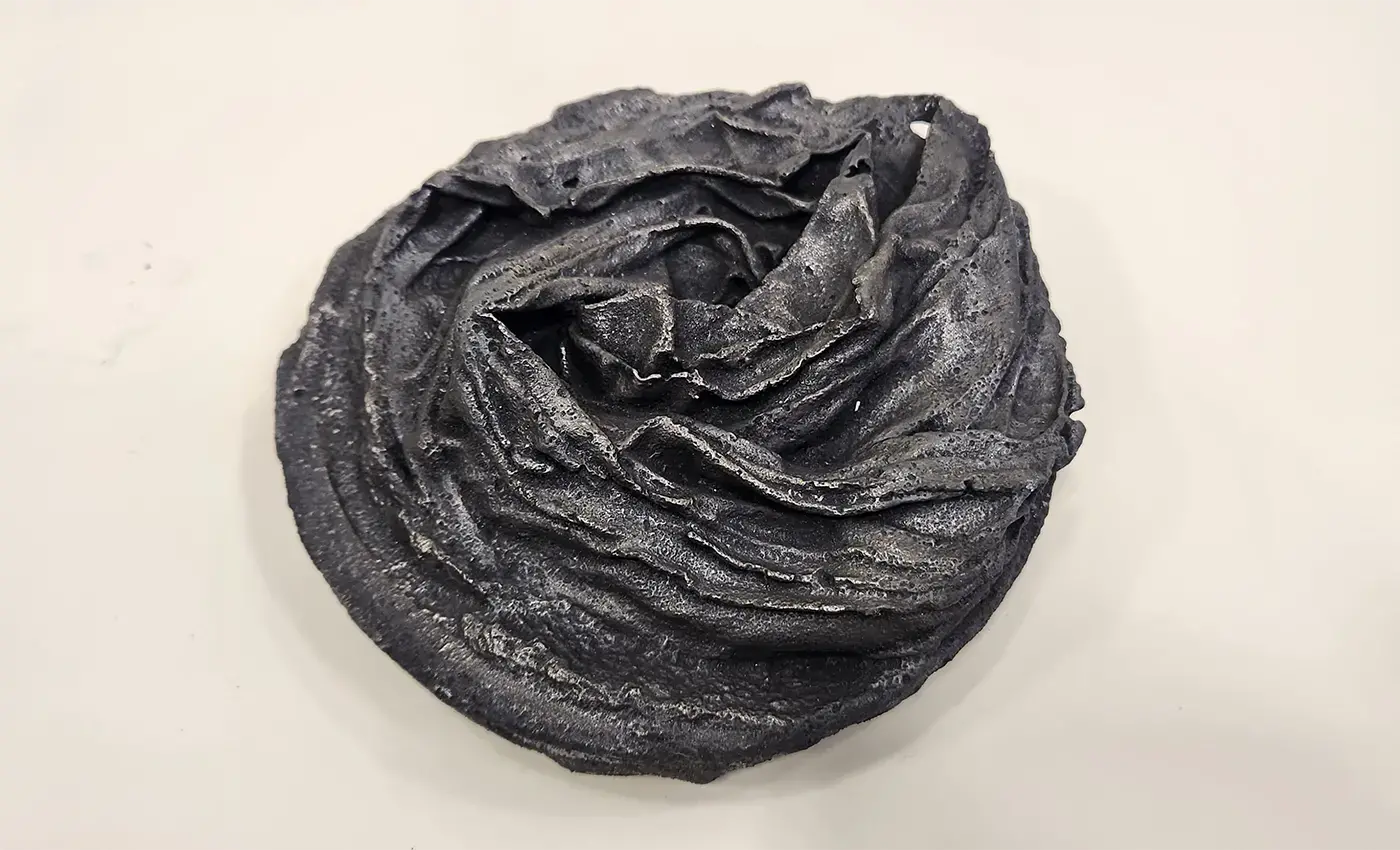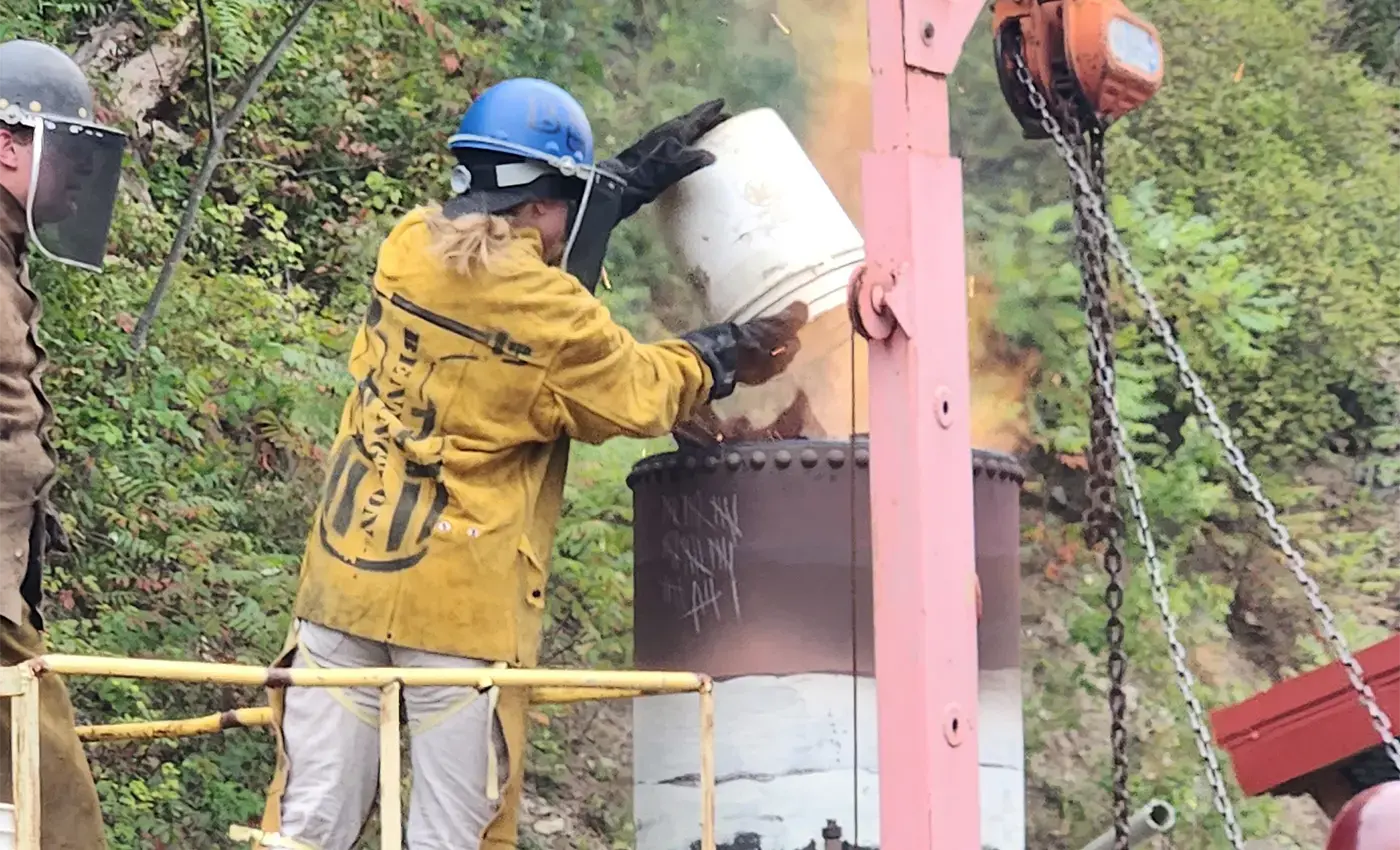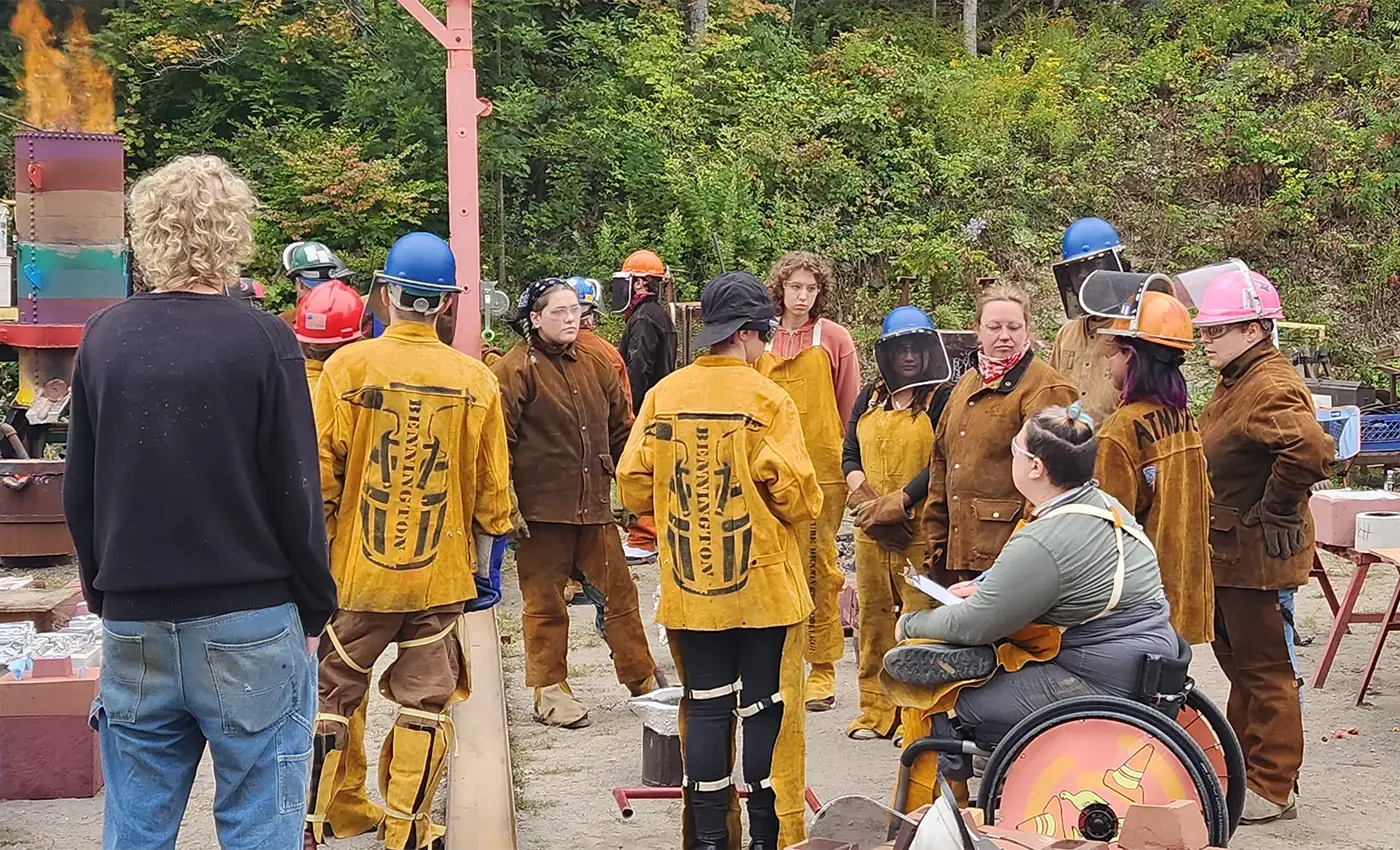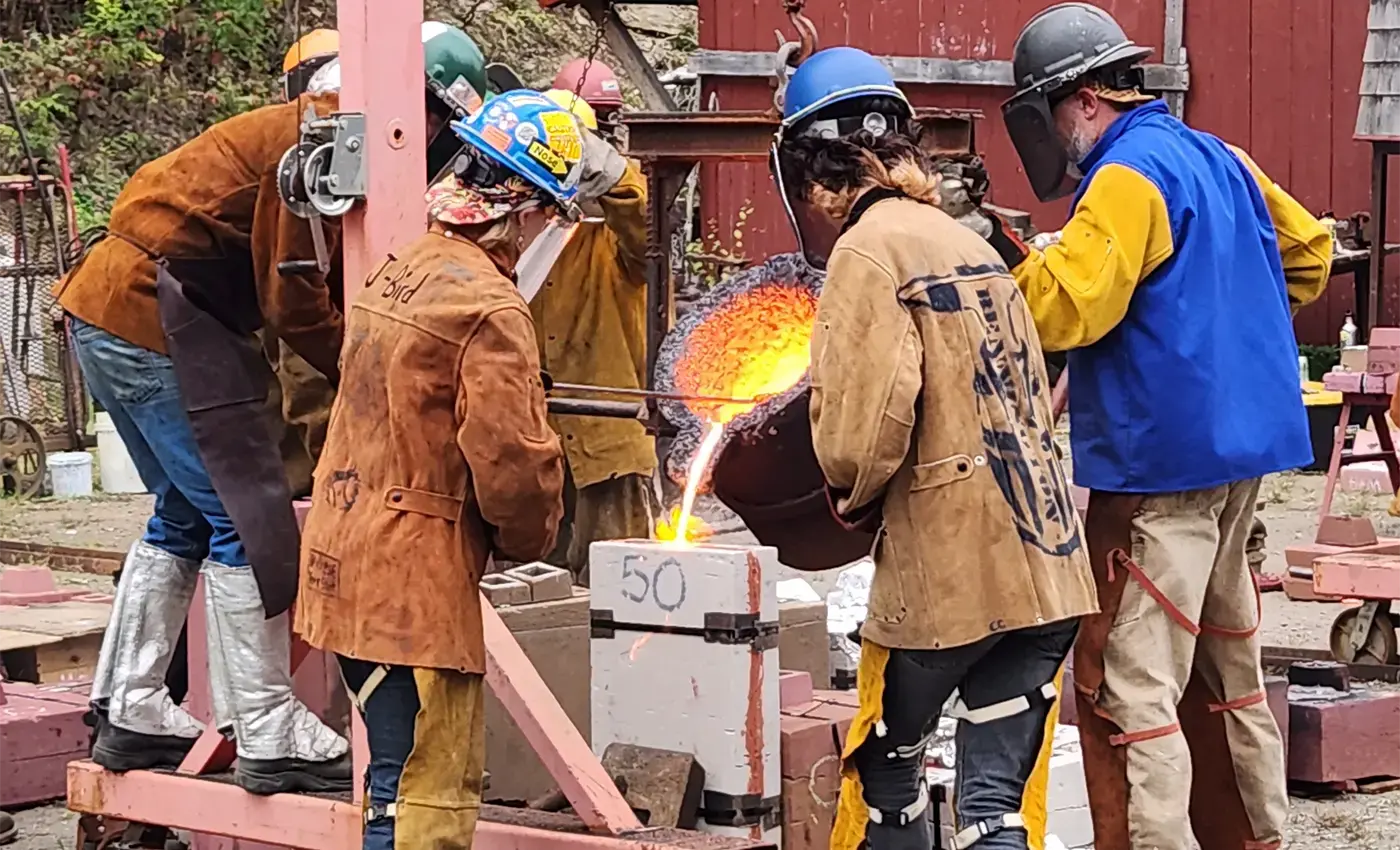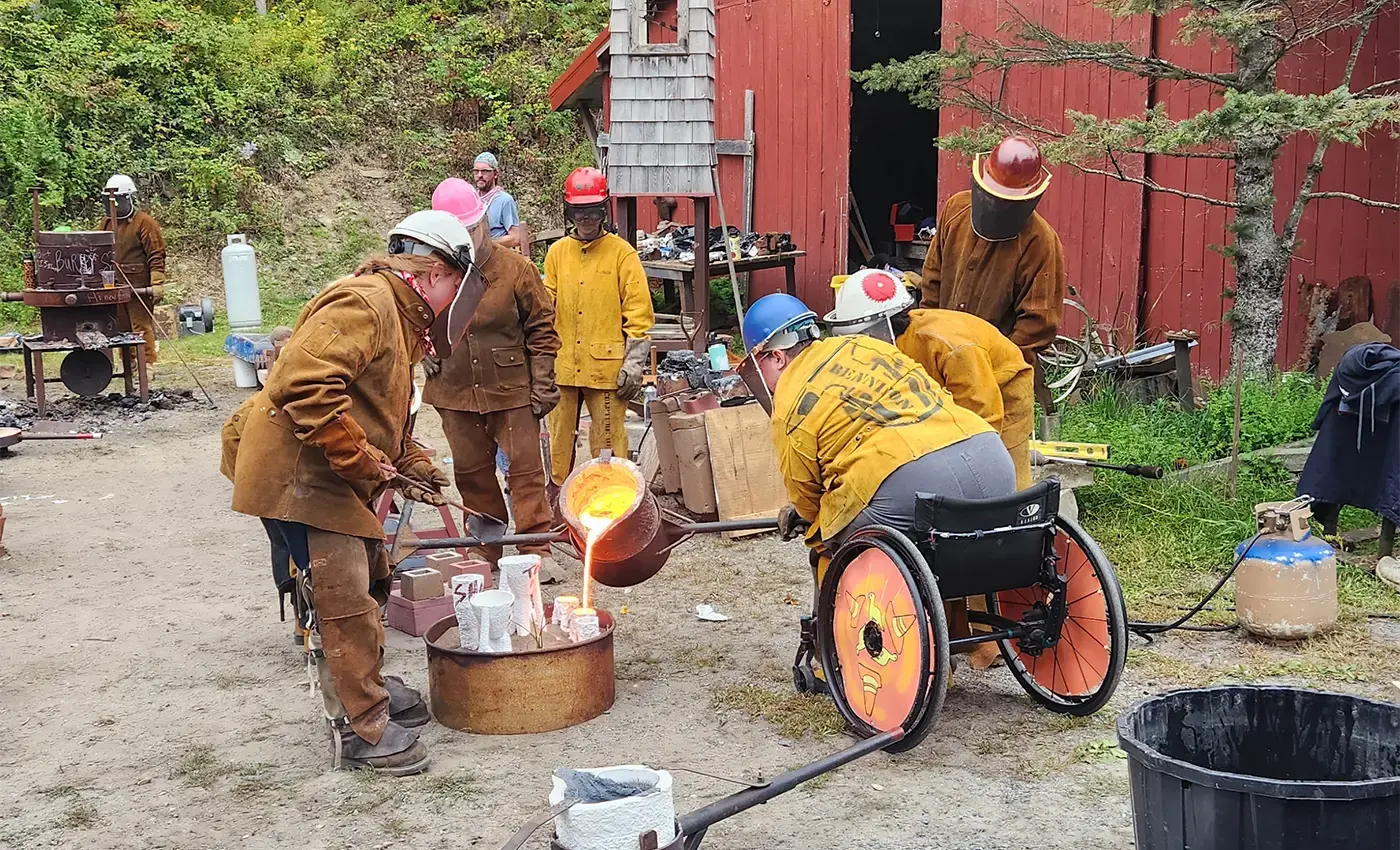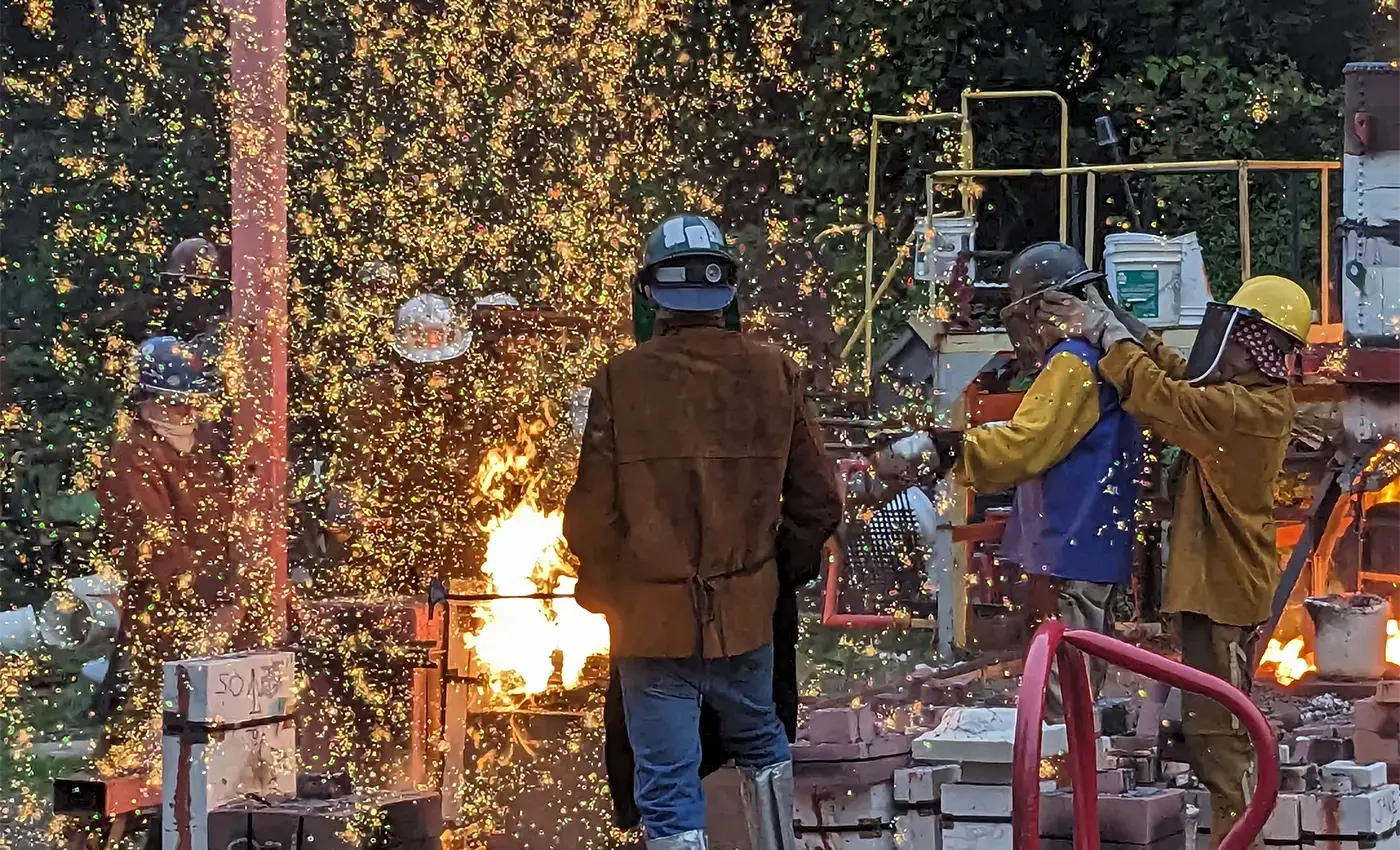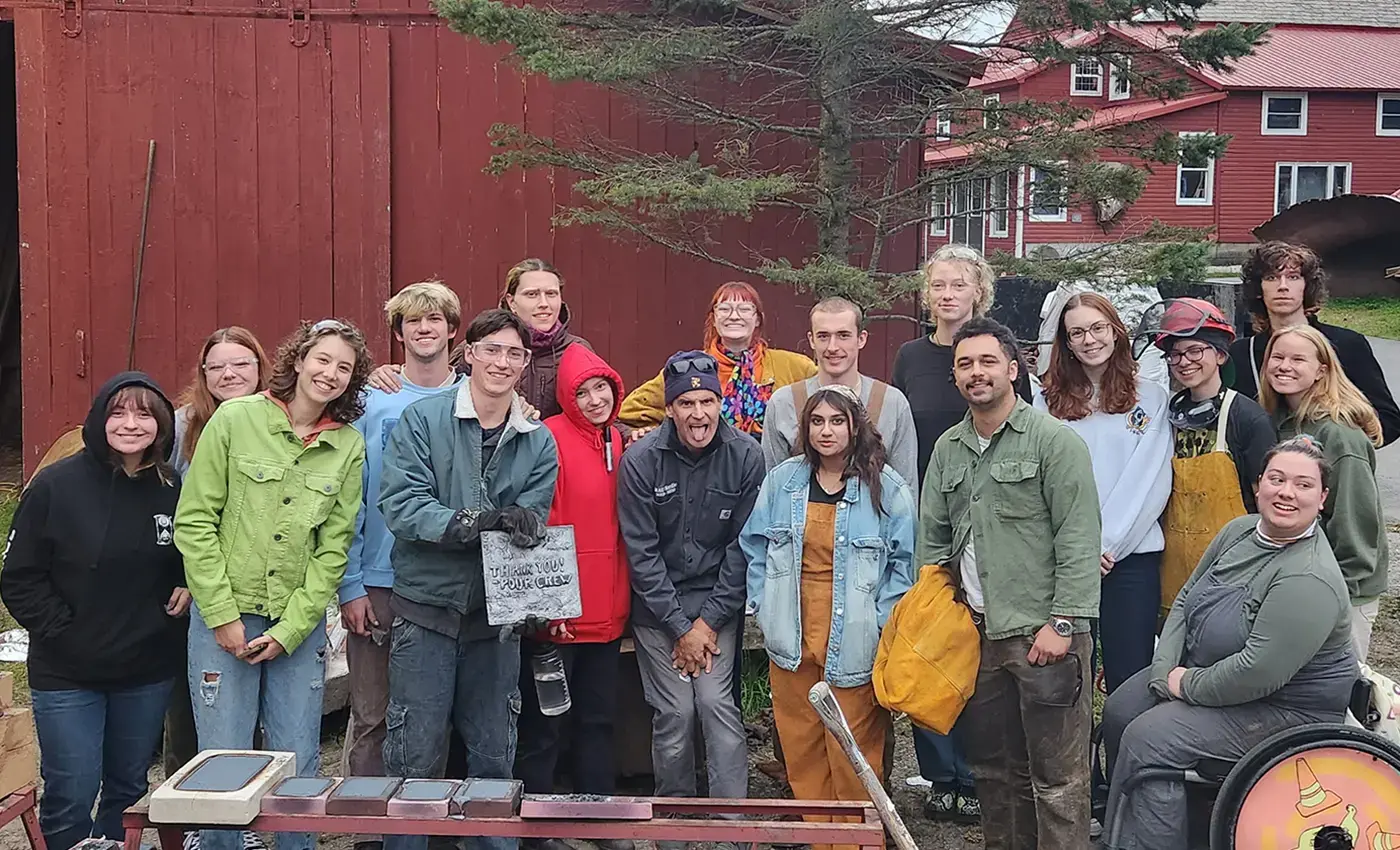Forging Connections Across the Art Community
During the first two weeks of the class “Examining Space,” eighteen students learned how to shape foundry wax and prepare sand molds for the purpose of conceiving and realizing an object in iron.
The class, taught by Sculpture Faculty John Umphlett, combined the physical and skill challenges of creating a mold alongside the artistic and philosophical tasks of thinking about not only what to cast in iron but why.
Jasmine Bete-Mitchell ’25—who studies music, visual arts, and dance—aimed to contrast the heavy dark quality of the material itself with an airier subject matter. Among her two molds was one of fabric swirled into a disk. “I have noticed that my artwork gets really emotionally heavy sometimes. I was worried that with iron, because it is such a heavy, dark substance, that it would be an emotionally terrible piece to look at,” she said. “I wanted to make something that brought lightness to the material.”
Other students’ works bridged the sculptural and functional. Sofian Holden ’25 studies visual arts and education and made a trio of belt buckles. “I like making functional things right now,” he said. “I wanted to be able to use it and wear it and also look at it.”
Drama, creative writing, and psychology student Maverick Yarger ’27 devised a mold of his fingers for the base of a cup. “I really liked the idea of casting one of my body parts,” he said. “And I wear a lot of rings, so I liked that I could incorporate that.”
To cast their molds, the students went to the Salem Art Works (SAW) in nearby Salem, NY, for the Festival of Fire. Anthony Cafritz ’85 founded the non-profit in 2005 and dedicated it to emerging and established artists and the creation and appreciation of progressive contemporary art. Set in a picturesque valley, the old dairy-farm-turned-art-makers-retreat was designed as an extension of the artistic offerings of nearby colleges. Students from colleges that didn’t have a forge or a glass shop could experience these modes of creating at SAW. Bennington students have used SAW in exactly the ways it was intended since its inception.
“I have had students do summer-long internships up there as well as glass works and iron works,” said Sculpture Faculty John Umphlett, who has known Cafritiz for many years. Beyond being a hub of artistic creation, the place breaks down the barriers between students and what they feel they can achieve, students and each other, and student artists and the broader artist community.
Festival of Fire
SAW’s Festival of Fire, an event held each September, celebrates the transformative nature of fire and simultaneously serves as the culmination of SAW’s busy season and the kick off to the academic year.
“We really hoped the Festival of Fire would be a chance to get all of your students together at the beginning of the semester in this place, so they could knit together and gather momentum,” Cafritz said during an interview just after having taught an all-day welding class to high school students. “It’s meant to distill and catalyze the energy and really forge a dialog and interdependence.”
Workshops, artist talks, demonstrations, performances, and exhibitions dot the festival schedule. Participants camp on the grounds, tour the sculpture park, and witness glass blowing, blacksmithing, welding. Some, like the Bennington students, join workshops where they cast their own molds in iron. This year, 85 participants ranging in age from their twenties to their seventies—including those from Bennington College, Alfred University, Skidmore College, the State University of New York at Cortland, Rivers of Steel in Pennsylvania, and independent learners—converged to use fire to make art.
The Festival of Fire has been “a binding thing” since it started, Cafritz said. People have made new friends and connections. People from different colleges meet and form partnerships. Iron pourers, especially, make up a small tightly knit community.
On the evening of Friday, September 22, students traveled 25 miles up NY-22 N to Salem to deliver their molds and see the first of several talks and demonstrations.
I thought it was beautiful. It was really cool to see so many sculptures all around,” said Holden. “When we first got there we walked to the pottery kilns. It felt very communal. Sofian Holden ’25
Yarger served as the mold master. “I had to have a list of all the molds, how many there were, which ones had to be watched, because they had to be hotter or were more delicate,” Yarger said. “I have never done anything like this before, so I was super excited that I got to be involved, but I was also a little bit nervous.”
Pouring Iron
Zac Ward MFA ’99 is the sculpture park manager and foundry director at SAW and supervised the iron pour on Saturday. He enjoyed getting to know the students and teaching them. “They are fun to have around,” he said.
Like Cafritz and Umphlett, Ward and Umphlett are old friends. They shared a light-filled studio in VAPA in the late nineties when they were both MFA students.
“The windows all rolled open. It was an amazing spot to be in,” Ward remembered. “We kept a little jive going.”
About teaching students to poor iron, Ward said, “I just encouraged them to stand near a job that they want to do. Stay out of the way; ask questions.” When the person doing the job felt they were ready, they let the student slide into place. “We need younger people to do the manual labor part,” Ward laughed.
Students jumped right in busting up iron and coal, known as “coke” in this context, into sizes that would fit into the furnace, said Umphlett. This method of teaching worked for students. Aliza Khan ’26 was nervous to participate at first.
I didn’t think I’d be as involved as I was, but everyone there was nice and supportive and wanted us to be involved. It was incredible fun. Aliza Khan '26
The combined action created a scene that was part industrial construction site, part steampunk workshop. Fire billowed. Sparks flew. An audience gathered. Someone remarked how it reminded them of the movie Mad Max. A Warhammer 40K fan compared it to the imagined behind-the-scenes world of the Orks.
Haley Cronin ’27 said, “there was always something to watch, especially during the pour, watching each individual job happen, people pouring coke or checking the bottom [of the furnace]. It was cool to see all the intricate work that goes into making sure the pour is successful.”
“Everyone participated in some way,” said Umphlett. “We had students fully outfitted to charge the furnace with iron and coke by the bucket load as well as actually pour a few of the molds with the molten iron.”
Transformation
Just as Cafritz had imagined, students formed bonds.
Julia Duva ’25 noted, “Art can be a very individual thing, so being able to work with other people in order to make art is a good experience.” She continued, “We were all invested in a personal project as well as the common goal of the class.”
Students also enjoyed being a part of a wider artistic community taking place outside of the academic environment.
Benjamin Alonso ’27 remarked, “It’s Impressive that we were there for an entire day and kept going and supported each other along the way. [It] felt like a community.”
Holden noted how the experience changed his perspective of life after Bennington. “I am starting to think about [what I will do] after school, and it was cool to see examples of people from Bennington doing so well and setting up their own environment and place to work,” he said.
They are pleased with their objects and eager to continue work in iron. “I really like how mine turned out,” said Yager. “It is a different texture, a bit more textured, than I thought, but I like that. I think it adds a cool vibe to it.”
“I feel like I spent just as much time working on my piece after the pour as before,” said Bete-Mitchell. “It was a big process of cutting off excess iron. But the finished product, I am really pleased with it.”
Umphlett was most proud of the personal and class growth he witnessed during the event. "Bennington College showed up strong and full of grace, ready to help others,” Umphlett said. And, he added, “the objects are incredible."
Cafritz predicted that the experience will galvanize students toward more creative and interesting collaborations. He said,
When students go back to their studios, they are colleagues. They are working together and working harder. They are on fire. Anthony Cafritz ’85
